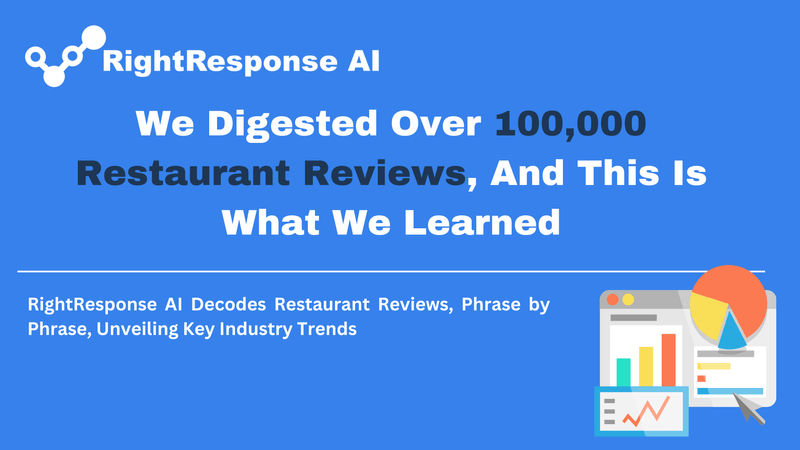
Introducing Advanced Customer Review Sentiment Analysis at RightResponse AI
Customer feedback is an underutilized yet invaluable resource for business improvement. The challenge has always been how to process unstructured data – customer reviews – and turn them into information that can be used to better meet customer needs.
RightResponse AI employs state-of-the-art methods to harness the full potential of sentiment analysis on customer reviews – our review management platform combines machine learning and aspect-based sentiment analysis within a customizable framework, designed to interpret customer reviews in exactly the way you think about your business. We equip businesses with the insights needed to not only grasp what their customers are saying but also understand the underlying reasons behind these sentiments—not only the “what” but the “why” of customer feedback.
This post will explore the evolution of sentiment analysis on reviews, highlight the shortcomings of older methods, and illustrate how RightResponse AI's approach allows businesses to better align their strategies with actual customer feedback.
What is Sentiment Analysis for Reviews?
Sentiment analysis for reviews is a specialized application of Natural Language Processing (NLP) that systematically identifies and categorizes the emotional tone of textual feedback into positive, negative, or neutral sentiments. This process converts the nuanced, unstructured opinions found in customer reviews into quantifiable insights, directly aiding businesses in understanding and leveraging consumer sentiments to inform strategic decisions and drive growth.
The Evolution of Keyword-Based Customer Review Sentiment Analysis
Historically, review sentiment analysis has largely been dominated by keyword-based techniques. This method hinges on identifying specific words within text that denote positive, negative, or neutral sentiments.
In its most basic form, keyword-based sentiment analysis relies on a static, predefined list of words to gauge the overall sentiment of text. However, this approach has evolved significantly over time.
A more sophisticated iteration involves dynamically deriving keywords from the text being analyzed, employing natural language processing (NLP) techniques to adapt to the specific language and expressions used by customers. This advancement marked a significant step forward, offering more flexibility and accuracy in interpreting customer feedback.
The Limitations of Dynamic Keyword-Based Sentiment Analysis: A Closer Look
Despite the advancements in dynamic keyword-based sentiment analysis, its limitations become apparent when faced with the complexities of human communication, which often condense into a single paragraph in a customer review.
One fundamental challenge is the requirement for exact keyword matches—terms like "burger" and "cheeseburger" are treated as distinct entities. Nuanced feedback might be missed if the review doesn’t use the exact term anticipated by the analysis.
For example, recognizing that staff is knowledgeable requires the exact word "knowledgeable," overlooking synonyms or related expressions that convey the same sentiment.
Or consider the challenge of detecting sarcasm with a review like, "Great service, waited only 2 hours for my meal," where positive words are used sarcastically to express dissatisfaction. This subtlety can easily be misinterpreted as positive feedback in keyword analysis.
The issue of emotional depth and mixed emotions is another significant challenge. A review stating, "The appetizers were amazing but the main course was a letdown," presents mixed sentiments within the same sentence—praise for one aspect and disappointment in another. Dynamically derived keywords might capture "amazing" and "letdown" but may struggle to accurately reflect the overall sentiment's nuance.
Negations and conditional sentiments add another complexity. For example, the phrase "I would love this place if it weren't so crowded" expresses a conditional positive sentiment that is negated by an undesirable condition, a structure that keyword-based systems find difficult to understand correctly.
Lastly, the method's effectiveness hinges on the clarity of the feedback. Ambiguous comments like "The experience was interesting" pose a challenge, as without explicit sentiment indicators, determining whether "interesting" is meant positively or negatively is difficult.
These examples highlight the nuanced limitations of dynamic keyword-based sentiment analysis in capturing the full spectrum of human sentiment expression, particularly when it relies on specific keyword matches that may not fully encompass the variety of ways customers express their opinions.
Customizing and Refining Customer Review Sentiment Analysis with ML and ABSA at RightResponse AI
RightResponse AI elevates customer review sentiment analysis to higher levels of precision and personalization by integrating Machine Learning (ML) and Aspect-Based Sentiment Analysis (ABSA). This sophisticated approach outshines traditional analysis by not just recognizing sentiments but also by understanding synonyms and contextually similar expressions, ensuring no valuable feedback is missed.

Examples Showing Why Review Sentiment Analysis Outperforms Keyword Analysis
For instance, whether a customer mentions that a staff member was "knowledgeable," "well-informed," or displayed "expert understanding," our AI engine interprets these varied expressions as reflecting positively on the "knowledge" aspect of service quality. This nuanced understanding allows for a broader and more accurate capture of customer sentiments, regardless of the specific vocabulary used.
Once a business defines its unique Categories and Topics, our ABSA engine meticulously analyzes customer feedback. It assigns sentiments to specific Topics determined by the client, capturing the essence of customer feedback with remarkable accuracy.

For example, statements across a range of synonyms and related expressions are intelligently categorized under the relevant Topics, such as "service" recognizing both "attentive" and "prompt" references.
Moreover, our ABSA engine doesn't stop at identifying sentiment; it also quantifies the strength of sentiment expressed on a nuanced scale from 1 to 5. This allows businesses to discern not just the nature of the sentiment but its intensity as well. By doing so, RightResponse AI offers a detailed emotional landscape of customer feedback, from mildly positive reviews to expressions of absolute delight or frustration.
The integration of customizable Categories and Topics, along with the ability to understand synonyms and gauge sentiment intensity, allows businesses to conduct a deeply personalized analysis of their customer feedback. This approach ensures that the ABSA engine aligns perfectly with the business’s conceptualization of its operations, providing insights that are directly actionable and strategically relevant.
How Accurate is Sentiment Analysis?
The accuracy of sentiment analysis varies significantly depending on the methodologies employed. As mentioned above, keyword-based sentiment analysis approaches can often result in inaccuracies as they struggle to grasp the context, sarcasm, or nuanced expressions of sentiment within textual data. In contrast, our platform, RightResponse AI, leverages large language models and Aspect-Based Sentiment Analysis (ABSA) to delve deeper into the text.
By examining not just the presence of certain keywords but the specific aspects mentioned and the sentiment attached to each, RightResponse AI offers a more nuanced understanding of customer feedback.
How To Scale and Visualize Sentiment Analysis on Reviews with RightResponse AI
At the heart of RightResponse AI's innovative approach is a robust application designed to handle sentiment analysis at scale, managing and interpreting tens or hundreds of thousands of customer reviews with ease. This powerful platform not only processes and categorizes feedback accurately but also provides intuitive, dynamic visualizations, making complex sentiment data comprehensible and actionable for our clients.
Experience the Future of Review Sentiment Analysis with RightResponse AI
Discover the transformative power of sentiment analysis tailored to your business's unique needs at RightResponse AI. We invite you to sign up for a free trial to experience firsthand how our advanced Machine Learning and Aspect-Based Sentiment Analysis can unlock actionable insights from customer feedback.
Customize your analysis with Categories and Topics that reflect your business model and leverage our nuanced sentiment strength scale to gain deep understanding of your customers’ perceptions and emotions.
If you have any questions or would like to dive deeper into how our technology can benefit your business, don't hesitate to contact us or book a conversation with one of our co-founders. Join us at RightResponse AI, where we're not just analyzing sentiment—we're redefining customer insight.
Try RightResponse AI free for 14 days
Get on top of your customer reviews to get the critical insightsyou need to improve customer acquisition and retention.
No obligation. No credit card required.
Try it free for 14 days
Read More from Our Blog

2024 Restaurant Diner Survey Insights

How to Respond to Negative Reviews

